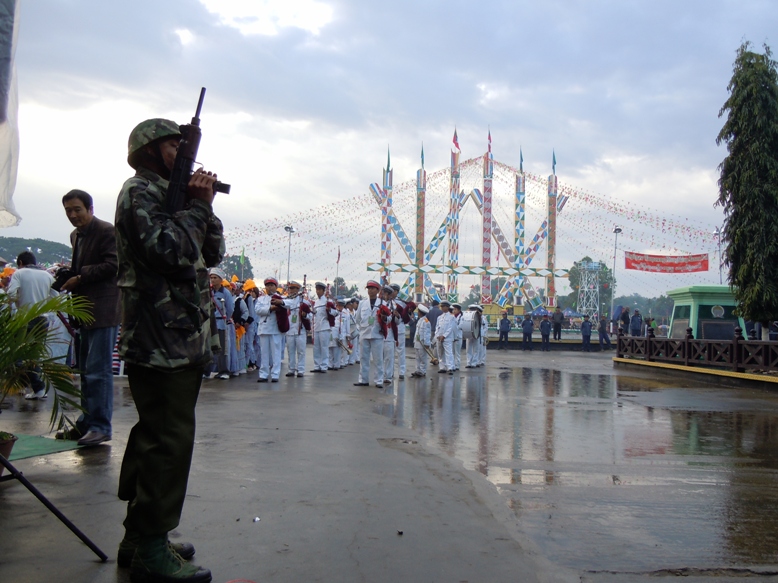In time there will be plenty of opportunities to provide thorough contextualisation and analysis of the new Kachin war in northern Burma’s Kachin State and Shan State. Starting with this one, here at New Mandala our Kachin-related posts from 2011 have made small contributions to understanding what has been going on.
Now, in the first week of October 2011, all of the attention has, quite rightly, focused on President Thein Sein’s audacious decision to suspend the construction of the Myitsone mega-dam project. This is the Chinese-backed hydro-electricity project being built at the confluence where the Ayeyarwady River begins. The project has never enjoyed popular support among the Kachin and a long-running campaign against the dam, originally confined to Myitkyina, has spread to other parts of the country. Aung San Suu Kyi is now also involved.
But there is something else which I think deserves to be highlighted if we are serious about getting a useful picture of the political and security dynamics in northern Burma right now.
Since the war between the Kachin Independence Army (KIA) and Burmese government forces re-ignited on 9 June 2011 there have been a large number of battle reports, many of which filter out to the rest of the world through the Kachin News Group.
From these sources we learn that in a single day of fighting earlier this week the KIA claims to have killed 40 government troops with no losses on its own side. Taken on its own this would be remarkable. But — as best we understand the long-term combat losses sustained by Burmese government forces — these numbers fit a months-long trend. As I have remarked previously, there have now been a number of engagements where the KIA claims to have killed dozens of Burmese soldiers.
My observation is that the total losses on the government side could now, by my count following the published KIA numbers, be approaching 500 soldiers killed. The KIA has suggested that the number is even higher.
This brings me to a set of ten major questions which I think deserve our serious attention:
- How reliable are the KIA numbers when it comes to Burmese government combat losses? How would we know?
- Are there smart ways of triangulating information about combat losses in a situation where all information is imperfect?
- If the Burmese government is losing so many troops in battle what impact does that have on their forces in terms of combat readiness, unit cohesion, command resilience, etc?
- Assuming that the KIA reports are largely correct, do Burmese government commanders see value in making tactical or strategic adjustments to help minimise future losses?
- The Burmese government almost never reports its own losses. Do senior military commanders (especially those based in Naypyidaw) have a good appreciation of what is happening to their troops in northern Shan State and eastern Kachin State? More provocatively, would they consider these reported losses unduly problematic if they are chalking up small victories along the way?
- If the numbers are reliable, what are the impacts across Burmese society from losing so many government troops so quickly? We should remember that almost all of those who die are relatively young and drawn from the junior ranks. They all have family and friends who will miss them.
- How are funerary arrangements managed? Are the bodies of slain Burmese soldiers returned to their families for cremation?
- What understanding of these combat losses filters through to Burmese society as a whole, or to the wider Burmese army system?
- How long can a Burmese Army Regional Command, or Special Operations Command, sustain this reported level of combat losses?
- Experiences from the Karen State, and elsewhere, suggest that the Burmese government is prepared to take heavy losses if there is a chance of grinding guerrilla opponents into the ground. But just have a look at the publicly reported information on combat losses from Karen National Liberation Army (KNLA) engagements. They tell us that in the first 6 months of 2011 the Burmese government saw 740 of its troops killed with 998 wounded. The KNLA claims that only 8 of its fighters were killed and 8 wounded during the same period. These are mind-boggling ratios; almost unbelievable. Is that the way the war with the KIA is headed and, if so, how long can it last?
Any answers from New Mandala readers — or even just general suggestions or related queries — are, of course, very welcome.
As I noted back in September we are now coming into the time of year when the rain stops falling in northern Burma. For both KIA and government strategists this has significant implications. There is much to ponder.
 Facebook
Facebook  Twitter
Twitter  Soundcloud
Soundcloud  Youtube
Youtube  Rss
Rss 